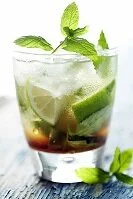Staple Foods
Beans: a side with many dishes and often served with rice
Rice: a common base to meals or simply a side dish; often served with beans
Regional Variations, Specialties, & Unique Dishes
Legim: beef or crab stew that usually includes eggplant, cabbage, spinach, and watercress, but can include many more vegetables
Poul Ak Nwa: found only in the north, this dish is made with chicken and cashews
Griots with Rice & Beans: the national dish consists of fried pork cubes, rice, beans, and bananas, usually covered with hot sauce
Tchaka: pork, bean, and pumpkin stew
Dining Etiquette
The Haitians have a mix of dining traditions between French, Caribbean, and Central American etiquettes. Generally the people are very laid back and easy going, but there are some dining rules all guests should try to adhere to. This begins with your arrival and dress as you may arrive a few minutes late and in casual clothing, but if meeting a business partner or going to a local's home dress a bit nicer as this shows respect.
As you enter the room to eat, allow women and "senior" men to enter first and allow your host to show you your seat. Couples are often separated and the seating tends to alternate between men and women so conversation can be encouraged. Often times drinks will be served with a meal and your host will welcome you with a toast of "salud." If not drinking, the meal will begin with the words "bon appetite."
As you eat use the continental style (knife in the right hand, fork in the left) and keep your hands within sight at all times by resting your wrists on the edge of the table. Once you have finished place your knife and fork together on the right side of your plate.
If you are eating in a restaurant, get the server's attention by making eye contact; don't wave or call his/her name. A gratuity is usually not included in your bill so be sure to add a tip of about 10% to the bill and hand all the money to your server directly.
Celebrations & Events
As with most Caribbean destinations, the celebrations in Haiti must begin with Carnival, which takes place just before the beginning of Lent. Although this celebration is now more about the music, dancing, and partying, its origin comes from a great over consumption that takes place just before Lent begins and remnants of this origin are still seen. During this time the people over indulge in meats and fatty foods prior to their Lenten requirements of fasting.
Other holidays, most particularly Christmas is celebrated with large feasts for families, but one unique aspect of this holiday is a drink called "kremas." Kremas is a local Haitian drink that is made of milk and rum and is most often served during the Christmas holiday, but can be found year round.
Drinks

Mojito
Haiti boasts all the popular drinks from teas and coffees to colas and milk, but juices and some unique drinks rule the nation. Among the more popular juices are guava, mango, orange, passion fruit, pineapple, and coconut milk/water among others. If you ever tire of the juice selection or are simply looking for something unusual try akasan, which is cornmeal, evaporated milk, sugar, cinnamon and other spices or try malta, which is flavored with barley and molasses.
Again, Haiti offers nearly every kind of alcoholic beverage available although some, including wine and some hard liquors are not real common. Beer is a mainstay on many menus and you can find both international brands as well as local beers, such as "Prestige." Rum is the other common beverage and the Haitians prefer the local "Rhum Barnancourt" although it can be expensive. A popular mixed drink using rum is cremas, a creamy coconut, milk, and rum drink; if you want an adventure, perhaps a slightly dangerous and ill-advised one, seek out kleren, the local moonshine.
The tap water in Haiti should not be consumed. Be sure to also avoid anything with ice as it may have been made from the tap water. Salads and fruits could have also been washed in the tap water so be careful with those foods as well.